Mythology of The Ram Across
Cultures
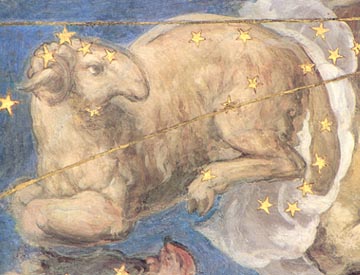 The astrological sign Aries is for many
people the most familiar connection to the symbol of the Ram.
Signaling the start of the vernal equinox, Aries is the first
of the twelve Zodiac signs and represents rebirth and renewal.
This is association not unique to astrology, which is itself the
distillation of many mythologies and belief systems. The ram figures
prominently in a diverse range of mythologies including
Pharoanic Egypt , pre-Christian Europe, Classical Greece, West
Africa, and the Judeo-Christian tradition and it is often
associated with celebrations of the "solar return" or
return of spring and fertility after the hiatus of winter. Below
is a survey of some the associations and practices surrounding
the image of rhe Ram across culutres.
The astrological sign Aries is for many
people the most familiar connection to the symbol of the Ram.
Signaling the start of the vernal equinox, Aries is the first
of the twelve Zodiac signs and represents rebirth and renewal.
This is association not unique to astrology, which is itself the
distillation of many mythologies and belief systems. The ram figures
prominently in a diverse range of mythologies including
Pharoanic Egypt , pre-Christian Europe, Classical Greece, West
Africa, and the Judeo-Christian tradition and it is often
associated with celebrations of the "solar return" or
return of spring and fertility after the hiatus of winter. Below
is a survey of some the associations and practices surrounding
the image of rhe Ram across culutres.
More on the origins of Aries in the
Zodiac: www.skyscript.co.uk/zodiachistory4.html
West African Traditions:
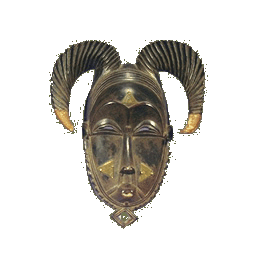 Ebune and Ikanga
Ebune and Ikanga
Ceremonies honoring the Ram,
or Ebune, are held to recognize the return of the rains
after dry, winter season. Ram masks often feature a white line
running down the central axis of the head. The line divides life
from death, light from darkness, and reinforces the notion the
Ram as the sign of rebirth or return from death. The Nigerian
Ibo figure of Ikanga is associated with Ebune, and
symbolizes resilience and strength. Ikangas have three distinct
phases of transformation, which mirror a personal transitions
that occur in life. The "young" Ikangas are largely
abrstract forms, while the elder Ikangas are figurative, "fully
formed" as it were. Rams' horns are the only constant throughout
the three phases, providing the strength and motivation necessary
to make the difficult journey from one phase of life to the next.
The qualities attributed to the Ikanga translate to other areas
of African ritual art, and horns of the Ram appear in many other
masks. Often the tips of the horns are given a color. Two common
colors are red and yellow: red, as deptiction of blood, embodies
assertive, decisive action, whereas yellow is associated with
change that comes through medecine or healing.
Shango, Saint Barbara, and
the Palm Leaf
In the Yoruba culture, the return
of the rains is recognized through the figure of Shango, an orisha,
or deity, who is represented by the Ram and is associated with
storms and thunder. Shango was a historical Yoruban king who was
killed and resurrected as a divinity. Shango is also present in
the Cuban tradition of Santeria and the Brasilian Candomblé
traditions, which were derived from West African religions imported
with colonial slaves and fused Catholic veneration of the saints.
Shango is associated with Santa Barbara, who is often depicted
carrying the palm leaf, a symbol of martyrdom. Palm leaves were
used by the Greeks and the Romans to signify triumph over death,
and thus were used to welcome Christ on his return from exile
in the desert, celebrated as Palm Sunday. In Caribbean and African
rituals, the palm plays prominent role, in particular as ritual
offerings to Ram spirits invoked by the mask.
Link to Museum of African Culture: www.tribalartmuseum.com
To learn mor about Shango:www.azodnem.com/Cauldron/Yemaja.htm
Egyptian Myth
Khnum and Amun
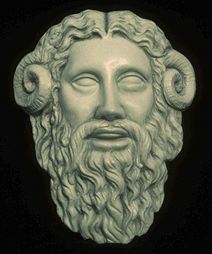
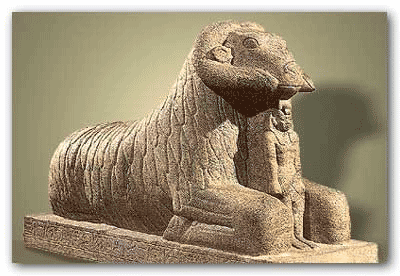 The
Ram, is the very beginning of the astrological cycle, appears
in early Egyptian myth as Khnum, who, like the Greek Prometheus,
is credited with the creation of the first men out of clay. One
imagines that this primordial clay would have been dredged from
the silt of the Nile, whose fertile, life-giving floods mark the
most important cyclic event in Egyptian agrarian life. Just as
the West Africans celebrated the return of the rains, so, too,
did the ancient Egyptians celebrate the annual life-giving flooding
of the Nile. The god responsible bringing the flood was the Ram-horned
Amun (one species of ram is today classified as ovis
ammun). Originally a god of the wind, Amun increased in importance
during the Middle Kingdom, supplanting the god of war and gradually
coming to dominate the Egyptian pantheon as its pre-eminent god.
He ultimately merged with Zues, as Ammon, during the Greco-Egyptian
Ptolemaic era (see image on left). As he evolved, Amun
assumed more control over aspects of the cosmos and eventually
merged with Re the Sun god, as Amun-Re. Thus, the annual return
of the sun in beginning the seasonal cycle was bound inexorably
to the Ram, as it still is in the Zodiac. Spring rites in Egyptian
religion (and later among the Romans) specifically celebrated
the shepherds.
The
Ram, is the very beginning of the astrological cycle, appears
in early Egyptian myth as Khnum, who, like the Greek Prometheus,
is credited with the creation of the first men out of clay. One
imagines that this primordial clay would have been dredged from
the silt of the Nile, whose fertile, life-giving floods mark the
most important cyclic event in Egyptian agrarian life. Just as
the West Africans celebrated the return of the rains, so, too,
did the ancient Egyptians celebrate the annual life-giving flooding
of the Nile. The god responsible bringing the flood was the Ram-horned
Amun (one species of ram is today classified as ovis
ammun). Originally a god of the wind, Amun increased in importance
during the Middle Kingdom, supplanting the god of war and gradually
coming to dominate the Egyptian pantheon as its pre-eminent god.
He ultimately merged with Zues, as Ammon, during the Greco-Egyptian
Ptolemaic era (see image on left). As he evolved, Amun
assumed more control over aspects of the cosmos and eventually
merged with Re the Sun god, as Amun-Re. Thus, the annual return
of the sun in beginning the seasonal cycle was bound inexorably
to the Ram, as it still is in the Zodiac. Spring rites in Egyptian
religion (and later among the Romans) specifically celebrated
the shepherds.
Amun-Re's solar return occurs
not only at the seasonal level, but as a daily cycle of death
and rebirth. The Egyptians believed that Amun-Re was obliged to
die each night to travel into the Underworld domain of Osiris.
With the dawn of each day Amun-Re is resurrected anew, and Osiris,
in homage to his diurnal counterpart, wears a head-dress of rams'
horns. The soul of Amun-Re is said to be a firebird, or bennu,
known more commonly by its Greek name, Phoenix (meaning
"red"). The Phoenix lives for a hundreds of years, ending
its life in a self-consuming conflagration, only to be reborn
from its own ashes. In the Phoenix one finds parallels to the
astrological Aries, associated with the element of fire; and in
West African tradition to the red-tipped horns of ram masks, and
to Shango, whose sacred color is red.
To learn more about Amun-Re and the
ram in Egytpian myth: www.touregypt.net/featurestories/ram.htm
Greek Myth
Aries, Argonauts, and Ares
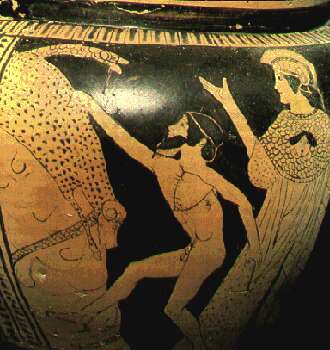 The solar return embodied in Amun-Re
is parallelled in the Classical Greek myth of Jason's quest for
the Golden Fleece. We inherit the constellation of Aries from
this myth, which depicts a golden Ram offered by the shepherd-god
Hermes to bear away the children of Queen Nephele, who feared
for their lives amidst palace intrigues. The grateful son of Nephele
scarifices the Ram upon his arrival in a kingdom far to the east
on the Black Sea. Jason and his crew set sail in the Argos to
claim the Golden Fleece from the sacred grove where it hangs,
an allegorical quest to reclaim the sun from its exile in the
east. To win the Fleece he must plow the field of Ares, who, like
Amun, was a god of war who evolved from earlier roots as an agricultural
deity.
The solar return embodied in Amun-Re
is parallelled in the Classical Greek myth of Jason's quest for
the Golden Fleece. We inherit the constellation of Aries from
this myth, which depicts a golden Ram offered by the shepherd-god
Hermes to bear away the children of Queen Nephele, who feared
for their lives amidst palace intrigues. The grateful son of Nephele
scarifices the Ram upon his arrival in a kingdom far to the east
on the Black Sea. Jason and his crew set sail in the Argos to
claim the Golden Fleece from the sacred grove where it hangs,
an allegorical quest to reclaim the sun from its exile in the
east. To win the Fleece he must plow the field of Ares, who, like
Amun, was a god of war who evolved from earlier roots as an agricultural
deity.
To Learn more about Jason and the Quest
for the Golden Fleece: www.bulfinch.org/fables/bull17.html
Celtic/ Nordic / Saxon
From Eostra to Easter
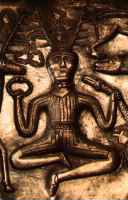
 Jason's
eastward journey to reclaim the Golden Fleece makes geographical
sense. Since the sun is reappears daily from darkness on the eastern
horizon, it is no accident that other cultures as well associate
the East with rebirth. The word "east" itself stems
from an obscure Germanic fertility goddess Eostra, who was celebrated
at the advent of spring, and from whose name we also get the words
for estrogen, and the Christian resurrection rite of Easter. Indeed,
one could say that the Judeo-Christian ritual tradition begins
and ends with the ram; from the ram that provides Abraham a sacrificial
surrogate for his son, to Christ's sacrifice and resurrection
as the "lamb of God."
Jason's
eastward journey to reclaim the Golden Fleece makes geographical
sense. Since the sun is reappears daily from darkness on the eastern
horizon, it is no accident that other cultures as well associate
the East with rebirth. The word "east" itself stems
from an obscure Germanic fertility goddess Eostra, who was celebrated
at the advent of spring, and from whose name we also get the words
for estrogen, and the Christian resurrection rite of Easter. Indeed,
one could say that the Judeo-Christian ritual tradition begins
and ends with the ram; from the ram that provides Abraham a sacrificial
surrogate for his son, to Christ's sacrifice and resurrection
as the "lamb of God."
Celtic myth describes Cernunnos
(right), a horned deity accompanied by ram-headed serpent. The
latter is possibly related to Jormangund, the giant Norse serpent
who body is wrapped around the world, his tail grasped in his
mouth symbolizing, again the theme of cyclic return. The Norse
version of the serpent is not said to be ram-horned, the image
at left portrays him with distinctly ovine features.
More about Ostara: http://www.pitt.edu/~dash/ostara.html
More about Cernunnos: http://www.geocities.com/ResearchTriangle/System/8870/memory/celtic.html
More on the Ram in Classical and Judeo-Christian
tradition: ww2.netnitco.net/users/legend01/ram.htm
 Back
to the Ebune Home Page
Back
to the Ebune Home Page
 The astrological sign Aries is for many
people the most familiar connection to the symbol of the Ram.
Signaling the start of the vernal equinox, Aries is the first
of the twelve Zodiac signs and represents rebirth and renewal.
This is association not unique to astrology, which is itself the
distillation of many mythologies and belief systems. The ram figures
prominently in a diverse range of mythologies including
Pharoanic Egypt , pre-Christian Europe, Classical Greece, West
Africa, and the Judeo-Christian tradition and it is often
associated with celebrations of the "solar return" or
return of spring and fertility after the hiatus of winter. Below
is a survey of some the associations and practices surrounding
the image of rhe Ram across culutres.
The astrological sign Aries is for many
people the most familiar connection to the symbol of the Ram.
Signaling the start of the vernal equinox, Aries is the first
of the twelve Zodiac signs and represents rebirth and renewal.
This is association not unique to astrology, which is itself the
distillation of many mythologies and belief systems. The ram figures
prominently in a diverse range of mythologies including
Pharoanic Egypt , pre-Christian Europe, Classical Greece, West
Africa, and the Judeo-Christian tradition and it is often
associated with celebrations of the "solar return" or
return of spring and fertility after the hiatus of winter. Below
is a survey of some the associations and practices surrounding
the image of rhe Ram across culutres. Ebune and Ikanga
Ebune and Ikanga
 The
Ram, is the very beginning of the astrological cycle, appears
in early Egyptian myth as Khnum, who, like the Greek Prometheus,
is credited with the creation of the first men out of clay. One
imagines that this primordial clay would have been dredged from
the silt of the Nile, whose fertile, life-giving floods mark the
most important cyclic event in Egyptian agrarian life. Just as
the West Africans celebrated the return of the rains, so, too,
did the ancient Egyptians celebrate the annual life-giving flooding
of the Nile. The god responsible bringing the flood was the Ram-horned
Amun (one species of ram is today classified as ovis
ammun). Originally a god of the wind, Amun increased in importance
during the Middle Kingdom, supplanting the god of war and gradually
coming to dominate the Egyptian pantheon as its pre-eminent god.
He ultimately merged with Zues, as Ammon, during the Greco-Egyptian
Ptolemaic era (see image on left). As he evolved, Amun
assumed more control over aspects of the cosmos and eventually
merged with Re the Sun god, as Amun-Re. Thus, the annual return
of the sun in beginning the seasonal cycle was bound inexorably
to the Ram, as it still is in the Zodiac. Spring rites in Egyptian
religion (and later among the Romans) specifically celebrated
the shepherds.
The
Ram, is the very beginning of the astrological cycle, appears
in early Egyptian myth as Khnum, who, like the Greek Prometheus,
is credited with the creation of the first men out of clay. One
imagines that this primordial clay would have been dredged from
the silt of the Nile, whose fertile, life-giving floods mark the
most important cyclic event in Egyptian agrarian life. Just as
the West Africans celebrated the return of the rains, so, too,
did the ancient Egyptians celebrate the annual life-giving flooding
of the Nile. The god responsible bringing the flood was the Ram-horned
Amun (one species of ram is today classified as ovis
ammun). Originally a god of the wind, Amun increased in importance
during the Middle Kingdom, supplanting the god of war and gradually
coming to dominate the Egyptian pantheon as its pre-eminent god.
He ultimately merged with Zues, as Ammon, during the Greco-Egyptian
Ptolemaic era (see image on left). As he evolved, Amun
assumed more control over aspects of the cosmos and eventually
merged with Re the Sun god, as Amun-Re. Thus, the annual return
of the sun in beginning the seasonal cycle was bound inexorably
to the Ram, as it still is in the Zodiac. Spring rites in Egyptian
religion (and later among the Romans) specifically celebrated
the shepherds. The solar return embodied in Amun-Re
is parallelled in the Classical Greek myth of Jason's quest for
the Golden Fleece. We inherit the constellation of Aries from
this myth, which depicts a golden Ram offered by the shepherd-god
Hermes to bear away the children of Queen Nephele, who feared
for their lives amidst palace intrigues. The grateful son of Nephele
scarifices the Ram upon his arrival in a kingdom far to the east
on the Black Sea. Jason and his crew set sail in the Argos to
claim the Golden Fleece from the sacred grove where it hangs,
an allegorical quest to reclaim the sun from its exile in the
east. To win the Fleece he must plow the field of Ares, who, like
Amun, was a god of war who evolved from earlier roots as an agricultural
deity.
The solar return embodied in Amun-Re
is parallelled in the Classical Greek myth of Jason's quest for
the Golden Fleece. We inherit the constellation of Aries from
this myth, which depicts a golden Ram offered by the shepherd-god
Hermes to bear away the children of Queen Nephele, who feared
for their lives amidst palace intrigues. The grateful son of Nephele
scarifices the Ram upon his arrival in a kingdom far to the east
on the Black Sea. Jason and his crew set sail in the Argos to
claim the Golden Fleece from the sacred grove where it hangs,
an allegorical quest to reclaim the sun from its exile in the
east. To win the Fleece he must plow the field of Ares, who, like
Amun, was a god of war who evolved from earlier roots as an agricultural
deity.
 Jason's
eastward journey to reclaim the Golden Fleece makes geographical
sense. Since the sun is reappears daily from darkness on the eastern
horizon, it is no accident that other cultures as well associate
the East with rebirth. The word "east" itself stems
from an obscure Germanic fertility goddess Eostra, who was celebrated
at the advent of spring, and from whose name we also get the words
for estrogen, and the Christian resurrection rite of Easter. Indeed,
one could say that the Judeo-Christian ritual tradition begins
and ends with the ram; from the ram that provides Abraham a sacrificial
surrogate for his son, to Christ's sacrifice and resurrection
as the "lamb of God."
Jason's
eastward journey to reclaim the Golden Fleece makes geographical
sense. Since the sun is reappears daily from darkness on the eastern
horizon, it is no accident that other cultures as well associate
the East with rebirth. The word "east" itself stems
from an obscure Germanic fertility goddess Eostra, who was celebrated
at the advent of spring, and from whose name we also get the words
for estrogen, and the Christian resurrection rite of Easter. Indeed,
one could say that the Judeo-Christian ritual tradition begins
and ends with the ram; from the ram that provides Abraham a sacrificial
surrogate for his son, to Christ's sacrifice and resurrection
as the "lamb of God." Back
to the Ebune Home Page
Back
to the Ebune Home Page